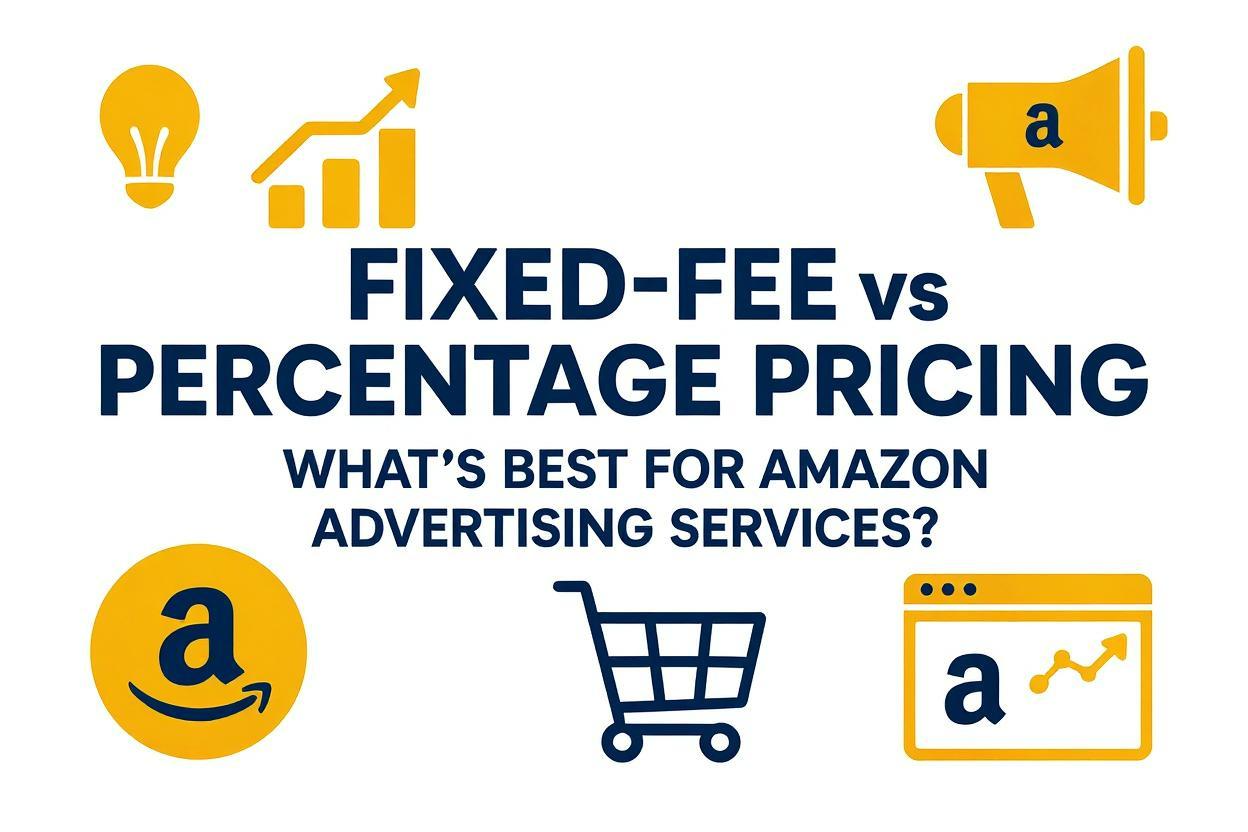
Introduction:
Amazon advertising services are booming – but how do you price them fairly? Should you charge a fixed monthly fee, a percentage of ad spend or sales, or a hybrid?
In this blog, we’ll break down the pros, cons, and use-cases for each pricing model to help brands choose the right agency structure and help agencies price their services profitably and transparently.
The 3 Common Pricing Models
1. Fixed-Fee Pricing
You charge or pay a flat monthly fee (e.g., $500/month) regardless of ad spend or sales.
Best for:
-
Smaller brands with consistent ad budgets
-
Agencies with systemized SOPs
-
Predictable workload and deliverables
Pros:
-
Simple billing
-
No surprises for clients
-
Easier for accounting and budgeting
Cons:
-
No upside incentive for agencies
-
Not scalable if workload increases
-
Brands may underpay or overpay based on actual results
2. Percentage of Ad Spend
You charge a percentage of the client’s ad spend (usually 10%–20%).
Example: $10,000 monthly ad spend → $1,500 fee at 15%
Best for:
-
Medium to large brands
-
Clients scaling aggressively
-
Agencies providing active bid & campaign management
Pros:
-
Scales with ad budget
-
Motivates agencies to push spend (and performance)
-
Transparent for brands spending more
Cons:
-
Doesn’t guarantee return (may reward inefficient spend)
-
Harder for clients with fluctuating budgets
-
Risk of mistrust if ROAS drops
3. Percentage of Revenue / GMV
You charge based on a percentage of sales generated (e.g., 3% of GMV).
Best for:
-
Full-funnel performance partnerships
-
D2C or Amazon brands with strong attribution
-
Agencies running both ads + listing + CRO
Pros:
-
True performance model
-
Risk-sharing motivates better performance
-
Aligned incentives
Cons:
-
Attribution disputes (especially with external traffic)
-
Reporting can get messy
-
May exclude brand-building or long-term value
4. Hybrid Model (Fixed + % Bonus)
Combines fixed base fee + performance bonus:
Example: $750/month + 5% of revenue above $30K
Best for:
-
Mature clients scaling with agency support
-
Balancing baseline operations + performance upside
Pros:
-
Security for agency
-
Motivation for overperformance
-
Works well for long-term retainers
Cons:
-
Needs transparent reporting
-
May require contracts or revenue validation
What Factors Should Guide Pricing?
| Factor | Considerations |
|---|---|
| Monthly Revenue | <$15K = fixed, $15K–$50K = % spend, >$50K = hybrid |
| Ad Spend | < $3K = fixed; >$5K = % makes more sense |
| Number of SKUs | More SKUs = more workload → higher fees |
| Tools Used | Advanced dashboards, automation = premium |
| Client Type | Startup? Brand? Marketplace seller? |
| Risk Level | Who handles creatives, listings, backend? |
Example Pricing Models in Action
| Client Type | Revenue | Ad Spend | Model | Fee Example |
|---|---|---|---|---|
| New Amazon Seller | $8K/mo | $1.5K | Fixed | $500/month |
| D2C Brand Scaling | $35K/mo | $7K | % of Ad Spend | 15% = $1,050 |
| Established Brand | $75K/mo | $12K | Hybrid (Fixed + %) | $1,000 + 3% > $50K GMV |
| Agency with Tool Use | $50K/mo | $10K | % of Ad Spend + Tool Fee | 12% + $200 dashboard |
What eCommercean Offers
At eCommercean, we follow a scalable hybrid model:
-
First 3 months: Fixed, transparent onboarding price (covers setup, analytics, tools)
-
Post onboarding: Either
a) Flat retainer
b) Percentage of GMV
We choose whichever is higher – aligning with both growth and stability.
This ensures we scale with the client, but don’t operate at a loss when volume is low.
Pro Tips for Brands & Agencies
If you’re a brand:
-
Ask for performance metrics (not just spend reports)
-
Demand clear attribution logic (Amazon Attribution, SQR, etc.)
-
Start with fixed, then move to hybrid once trust is built
If you’re an agency:
-
Offer ROI-based dashboards
-
Use SOPs and automation to scale fixed-price clients profitably
-
Offer audits or tool-based insights to upsell retainers
Conclusion:
There’s no one-size-fits-all model – but transparency, scalability, and alignment are non-negotiable. Fixed pricing gives stability, percentage rewards performance, and hybrids strike the perfect balance.
Want to work with an agency that adapts to your brand’s growth? Explore eCommercean’s Growth-Ready Pricing Models and book a discovery call today.
